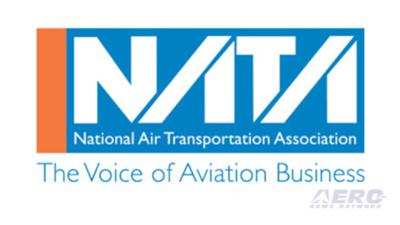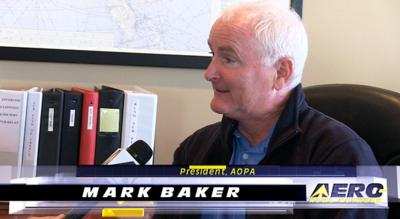Associations Maintain Skepticism About The Proposal
It's no surprise that not all segments of the aviation industry are supportive of President Donald Trump's plan to privatize Air Traffic Control services in the United States.

Reaction to the plan from business and general aviation associations began to come in quickly following Monday's East Room speech outlining, but giving few details about the plan. In a statement released to the media shortly after the speech ended, NBAA president and CEO Ed Bolen (pictured) said that the plan heavily favors airlines over business aviation and GA. “NBAA has worked for many years to promote technologies, policies and procedures that ensure America’s aviation system remains the largest, best, safest and most diverse system in the world, Bolen said. “We are deeply concerned with the president’s call for ATC privatization – a concept that has long been a goal of the big airlines. No one should confuse ATC modernization with ATC privatization – the two are very different concepts.
“Unfortunately, the recent discussion about privatization is really about the airlines’ push to gain more control over our air traffic control system, so that they can run it for their own benefit, and is a sideshow to a serious and constructive discussion about building on the progress currently underway on NextGen,” Bolen said. “We are concerned that those left behind under ATC privatization would be the citizens, companies and communities that rely on general aviation for all manner of services," Bolen said.
Proposals for privatizing ATC have been pushed by the airlines and their supporters as part of the continuing congressional debate over reauthorization of funding and programs for the FAA. The concept has raised concerns among members from both sides of the aisle in the House and Senate, mayors from across the country and a majority of Americans. Organizations on the political left and right of center have also raised concerns, including that the details for ATC privatization included in the president’s most recent budget documents may increase the deficit.
Aviation groups have also opposed the concept, and today, a host of aviation organizations sent a joint letter to the White House signaling continuing concerns over ATC privatization. “NBAA continues to be focused on the goal of aviation-system modernization, and we will work with the Congress and administration to make that a reality,” Bolen added. “At the same time, we will ensure that the business aviation community is vigilant and ready to mobilize on any legislative proposals that would distract or hinder progress on modernization.”
NATA president Martin H. Hiller said emulating systems used in other countries might not be in the best interests of the U.S. “It’s difficult to see how one 'Makes America Great Again' by emulating foreign air traffic control systems that are smaller and demonstrably less safe than our own," Hiller said in a prepared statement released to the media. "The Trump proposal introduces significant uncertainty to the world’s largest, most complex and safest air traffic control system, offering a radical solution to issues that can be addressed within the FAA’s current framework. Surprisingly, the proposal also makes little business sense, it does nothing to address the need for additional airport infrastructure investment but adds significantly to annual budget deficits and increases the costs to be borne by the non-flying public.

"This is yet another Trump Administration slap at rural America. The Administration recently proposed slashing support for rural air service but now talks about maintaining rural access. What are those services and how do you maintain them? Instead, the Trump proposal indicates access for rural America will be limited to their willingness to pay whatever the airlines demand. Corporatizing air traffic control further limits the public’s ability to address issues of concern, removes transparency in ticket costs and undermines general aviation. General aviation groups will share those concerns in a joint industry letter to President Trump later today.
“To ensure safety, air traffic control modernization is a deliberate process and it is misleading to think privatization will change that. In fact, most current delays are attributed to airline systems, suggesting that just because something is done by the private sector does not make it necessarily better,” Hiller said.
“The proposal forces the FAA to accept potentially profound changes in air traffic procedures without allowing for the scrutiny that has given us the world’s best safety record. There is no conflict of interest at the FAA, the Aviation Safety and Air Traffic organizations are already separate entities inside the agency. The Trump proposal is a step-back, to a time when effort was wasted because air traffic systems were developed without a clear understanding of total safety requirements and subsequently had to be modified or scrapped.
“The FAA (including air traffic) is funded almost exclusively from current aviation taxes. The Administration proposal adds to the annual budget deficit by $46 billion and increases the amount of revenue expected to be paid from the non-traveling public. The proposed scheme would make it impossible for the flying public to determine how much of the cost of their airplane ticket can be attributed to air traffic control. Worse, reducing public oversight means citizens will have no recourse for addressing concerns like noise, and system users will be at the mercy of the Secretary of Transportation to determine what’s a fair cost.
“The Administration is correct in its call for FAA to migrate to a performance-based regulatory framework. And there is even more that can be done within the agency’s current framework, including modifying the budget rules to protect the FAA from the uncertainties created by sequesters and government shutdowns. Finally, reclaiming the hundreds of millions of dollars lost annually to the Highway Trust Fund and increasing the use of the performance-based contracting are all readily achievable steps that do not require the radical and potentially dangerous step of corporatizing air traffic control,” Hiller concluded.

AOPA president and CEO Mark Baker said the plan could result in unintended consequences for GA. “While AOPA is open to proposals aimed at making the air traffic control system more efficient and delivering technology in a timely and cost effective manner, we have consistently said we will not support policies that impose user fees on general aviation. As the air traffic debate continues, we are also concerned about the impact of these proposed reforms on general aviation based on what we have seen in other countries. We applaud President Trump’s calls to invest and improve our nation’s infrastructure including our airports. However, the U.S. has a very safe air traffic system today and we don’t hear complaints from our nearly 350,000 members about it. We will continue to work with the Administration and members of Congress including the General Aviation Caucus to ensure that safety, access, cost, and the freedom to fly are protected and addressed,” Baker
said.
GAMA also took issue with the assertion that the privatization model that has been successful in other countries would automatically be successful in the U.S. Though the president outlined in his principles that over 50 countries have made a successful transition over the last 20 years, none have been close in scope or size to the United States system. Government Accountability Office research has shown that the average time for a transition of an air traffic control system to a private entity in other countries has been five-to-seven years. A transition in the U.S. would likely take as much, if not more time, due to its size and complexity. Additionally, research shows these transitions can create financial risk to the user community and the taxpayers. With the president’s principles outlining that the new entity will receive all current government assets at no cost, payment for environmental liabilities associated with the asset transfer and spectrum use free of charge, it seems the federal
government will need to subsidize this private entity. This entity will then be allowed to compete against private sector companies that do not receive such support.

The U.S. Congress, working with stakeholders and FAA, has implemented equitable solutions to challenges like rural and small community service, fair access for all aviation users, environmental impacts of noise and traffic, infrastructure and funding mechanisms. The FAA has also managed the safe integration of new technologies into the National Airspace System because it is chartered to serve a broader public purpose. There is no guarantee that this new entity could run the safest, busiest and most complex airspace in the world, while simultaneously increasing the pace and impact of modernization and assuring the American people that it will, first and foremost, serve the public interest.
Transitioning the current air traffic system to a new entity could delay progress on air traffic modernization under the FAA’s NextGen program, which is yielding benefits for the U.S. air transportation system, economy and American jobs. Instead of delaying such progress, we could continue its advancement while also making targeted improvements to ensure more financial flexibility for the FAA as well as better tools to manage major capital programs.
GAMA has also joined a host of general aviation associations in sending a letter to President Trump in response to the Administration’s principles on air traffic control privatization, including user fees. The letter states, “Today, the U.S. air traffic control system is the best in the world, moving more aircraft, more safely and efficiently, than any other country. Working with Congress and the FAA, aviation stakeholders have been able to ensure that our system operates for the public benefit, providing access for all stakeholders to airports, heliports and airspace, and encouraging competition and innovation.”
(Source: Media releases as cited. Images from file)
 ANN's Daily Aero-Term (04.20.24): Light Gun
ANN's Daily Aero-Term (04.20.24): Light Gun Aero-News: Quote of the Day (04.20.24)
Aero-News: Quote of the Day (04.20.24) ANN's Daily Aero-Linx (04.21.24)
ANN's Daily Aero-Linx (04.21.24) Aero-News: Quote of the Day (04.21.24)
Aero-News: Quote of the Day (04.21.24) ANN's Daily Aero-Term (04.21.24): Aircraft Conflict
ANN's Daily Aero-Term (04.21.24): Aircraft Conflict






